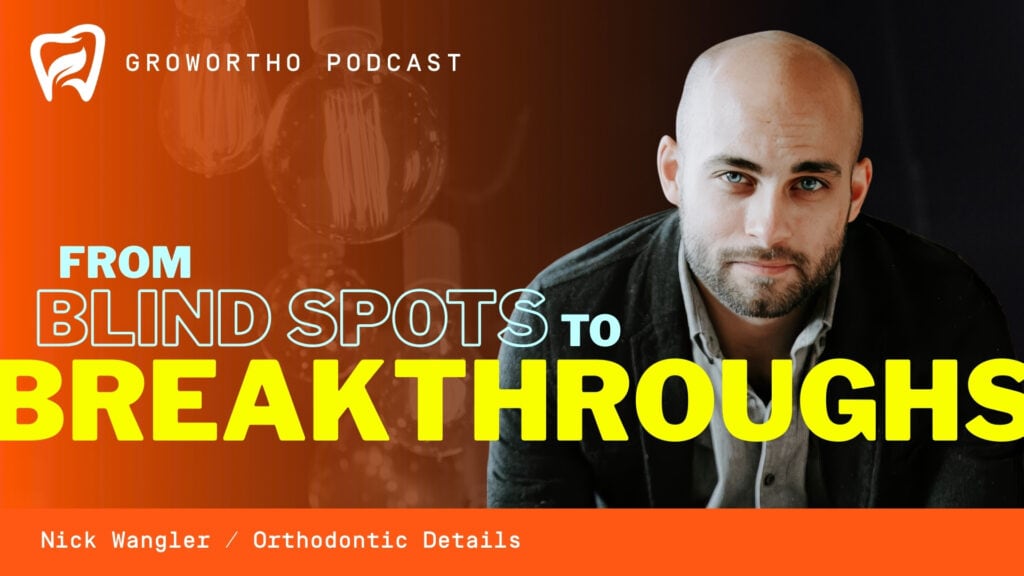Subscribe: RSS
Why Every Orthodontist Has Blind Spots
Every orthodontic practice has blind spots. The difference between the offices that grow and those that stall often comes down to proximity—how close the doctor is to the real issues impacting the business. In this episode of the podcast, we’re joined by Nick Wangler, co-founder of Orthodontic Details, to explore why these blind spots form, how to close the gap, and why proximity is power when it comes to orthodontic practice growth.
When you stay close to your challenges, you see problems sooner, make better decisions, and turn obstacles into breakthroughs. This conversation with Nick offers practical insights and strategies you can use immediately to strengthen both your business and your leadership.
The Hidden Cost of Distance
Business relationships don’t work the same way as patient relationships. Suppliers, marketing partners, and banks are not evaluating you on bracket placement or aligner precision—they care about systems, numbers, and results. Over time, your identity as “the doctor” can merge so closely with your sense of worth that acknowledging a business challenge feels like admitting clinical failure. It’s not the same thing, but it feels that way.
This distance from the business side often starts small—skipping a financial report, delegating without proper follow-up, or avoiding operational meetings. These aren’t signs of laziness; they’re signs of cognitive protection. When you’re performing complex orthodontic treatments, your brain pushes aside operational concerns to keep you focused on patient care. Unfortunately, that same protection creates gaps where small problems quietly grow.
Why Proximity Is Power in Orthodontic Practice Growth
The further you are from a problem—physically, mentally, or emotionally—the less likely you are to solve it quickly. Proximity gives you faster awareness, better data, and greater control over outcomes. When you close the distance, you can identify issues before they escalate, spot growth opportunities earlier, and make decisions based on reality rather than assumptions.
Proximity also creates momentum. When you have your finger on the pulse of your practice, you can adapt faster, keep your team aligned, and maintain a competitive edge in a changing orthodontic market. As Nick Wangler, founder of Orthodontic Details, points out, proximity isn’t about micromanaging—it’s about having the awareness to see problems early and act decisively.
A Practical Plan to Turn Blind Spots into Breakthroughs
The best way to close the gap is to implement systems that keep you close to the truth—without overwhelming your schedule.
-
Pick one area you’ve been avoiding—whether it’s reviewing your numbers, evaluating your systems, or checking in on team dynamics.
-
Schedule a short weekly review—just 15 minutes to assess your new patient flow, team satisfaction, and operational efficiency.
-
Create feedback loops—include patient surveys, team input sessions, financial reviews with your accountant, and regular check-ins with trusted advisors.
The goal is not perfection—it’s consistent proximity. The closer you are to the facts, the faster you can make changes that matter.
The Patient Experience Connection
Proximity doesn’t just benefit you—it benefits your patients. They expect more than outstanding treatment; they want a smooth, stress-free experience from the moment they walk in until the day they finish care. Delivering that requires efficient systems, clear communication, and reliable processes.
When you apply the same precision you use for bracket placement and aligner planning to your scheduling, billing, and marketing systems, you elevate the patient experience and build a stronger reputation in your community.
Quick Win: Get Closer to Your Supply Chain
One of the easiest places to gain proximity is in supply ordering. Many orthodontic practices juggle multiple vendors, deal with inconsistent pricing, and lose staff time to chasing orders. Nick Wangler and his team at Orthodontic Details solve this by consolidating suppliers into one platform, negotiating better pricing, and providing a concierge team to handle issues—so your team can focus on patient care.
Visit orthodonticdetails.com to see how they help practices nationwide gain clarity, efficiency, and peace of mind.
From Blind Spots to Breakthroughs Starts Today
From blind spots to breakthroughs—the path begins with getting closer to the truth. The smaller the gap between you and your business challenges, the faster you can turn them into growth opportunities. If you want to see true orthodontic practice growth, commit to closing the distance this week. Pick one area, get closer to the facts, and watch how quickly you move from reactive to proactive.
Proximity isn’t just a leadership principle—it’s your competitive advantage.



